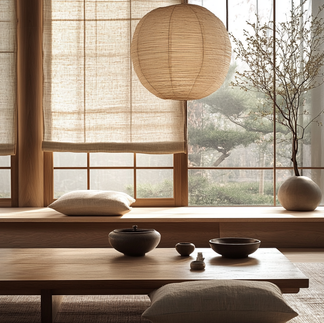Design Philosophies That Shape Aartium
- Mic GC
- Apr 10
- 4 min read
In architecture and interior design, philosophies are more than abstract ideals—they are the invisible threads that stitch together thought, emotion, and aesthetics into a coherent spatial narrative. At Aartium, our work is guided by philosophies that transcend trends, rooting each project in timeless principles. These design philosophies offer us a compass, helping us understand space not only as form and function but as experience and expression.
Design philosophies act as a lens through which beauty, function, and purpose are examined. They give weight to decisions—from the feel of a doorknob to the tone of natural light across stone. When infused into our studio’s design process, these philosophies create interiors and buildings that are not only beautiful but emotionally resonant, intellectually stimulating, and spiritually grounding.
Philosophies We Live and Design By
Shibumi (渋み): The Beauty of Quiet Refinement
Shibumi represents a kind of beauty that doesn’t shout but whispers. It speaks through restraint, calm, and sophistication that comes not from embellishment but from clarity and purpose. In architecture, this might look like a space with natural materials, a soft neutral palette, and just enough texture to suggest tactility without overcomplication. Imagine a teahouse—sunlight sifting through rice-paper screens, the quiet grain of cedar underfoot. That’s Shibumi.
Shibusa (渋さ): Timeless Subtlety
Where Shibumi hints at effortless elegance, Shibusa suggests enduring depth. It’s the design that doesn’t overwhelm you on first impression but slowly reveals its richness over time. In residential interior design, this may take the form of a hand-thrown ceramic basin or a time-worn wooden stair railing. These elements, crafted with patience and precision, mature beautifully—getting better, not worse, with use.
Wabi-Sabi (侘び寂び): Embracing Imperfection
Wabi-sabi is an homage to impermanence. It honours nature’s irregularities and the charm of things that are incomplete. It teaches us to see beauty in the imperfect—a cracked glaze, a weathered surface, or the asymmetry of hand-formed objects. It’s where craftsmanship meets soul. At Aartium, we embrace wabi-sabi by allowing materials to age gracefully, incorporating found objects, and respecting the stories that each piece brings with it.
Pietra Serena: Italian Renaissance Clarity
Pietra Serena, meaning "serene stone," offers a minimalist yet classical approach rooted in Renaissance balance. Think of Florence—its measured arches, quiet courtyards, and harmonious proportions. We use this philosophy to create spaces of grandeur that never slip into pretension. Pale grey stone, tall windows, and silence as texture—this aesthetic invites contemplation and respect.
Minimalism: The Essential as Beautiful
Minimalism, particularly in its Western interpretation, is the pursuit of clarity through reduction. At Aartium, minimalism is never cold or clinical—it’s purposeful. It’s about removing what distracts to elevate what remains. Picture a gallery-like living room: one sculptural chair, washed walls, oak flooring. Everything has its place and reason. Here, function shapes form and intention defines beauty.
Rustic Elegance: Raw Meets Refined
Rustic Elegance speaks to the soul of our material choices—raw but considered, timeworn but graceful. It is the blend of authenticity and sophistication. We see it in the interplay between weathered timber beams and soft woven textiles, a gentle juxtaposition of strength and softness. In remote retreats or countryside residences, this is where memory and material meet.
Aartium’s Process: Philosophy in Practice
Each of these philosophies isn’t a checkbox for us—it’s a muse. When we sit down to develop a concept, we ask: how do we want this space to feel? Calm like Shibumi? Lived-in like Wabi-sabi? Timeless like Pietra Serena? These questions guide our spatial narratives.
From the earliest sketches to material sourcing and final detailing, these principles infuse our entire approach to architectural and interior design. For instance, selecting locally sourced materials becomes not only an ecological choice but also a philosophical one, reflecting Shibusa’s appreciation of time and place. Smart storage solutions and seamless detailing echo Minimalist restraint. The use of live edge wood and natural fabrics ties into Wabi-sabi and Rustic Elegance.
Real-World Applications
Practically, these philosophies help us craft spaces that are both visually refined and deeply personal. In a luxurious residential design, Shibumi might be expressed through custom joinery that quietly integrates into the walls, avoiding overt ornamentation. In a hospitality project, Wabi-sabi can be brought to life with handmade tiles and textured plaster walls that invite touch and evoke story.
Cradle to cradle design, a principle aligned with sustainable and regenerative thinking, integrates beautifully with these philosophies. Reclaimed wood beams in a Pietra Serena-inspired villa or earthen finishes in a Wabi-sabi guesthouse aren’t just eco-conscious—they’re philosophically aligned with how we see and value the world.
Why Philosophy Matters in Design
Design is not just visual. It’s emotional, philosophical, experiential. It is the tactile feel of stone underfoot, the sound of wind through a courtyard, the glow of evening light on clay walls. When philosophy anchors a project, the space transcends functionality—it becomes a living story.
At Aartium, we believe that embracing deep, diverse philosophies not only enhances the work itself but also enriches the lives of those who experience it. Whether it's a quiet mountain hideaway, a sculptural city loft, or an immersive eco-hotel, our goal is always the same: to create meaningful, sensory-rich spaces that honour both place and people.
In a world often obsessed with the fast and the flashy, we remain committed to the enduring—designs that breathe, adapt, and resonate. That is our philosophy. That is Aartium.







































































Comments